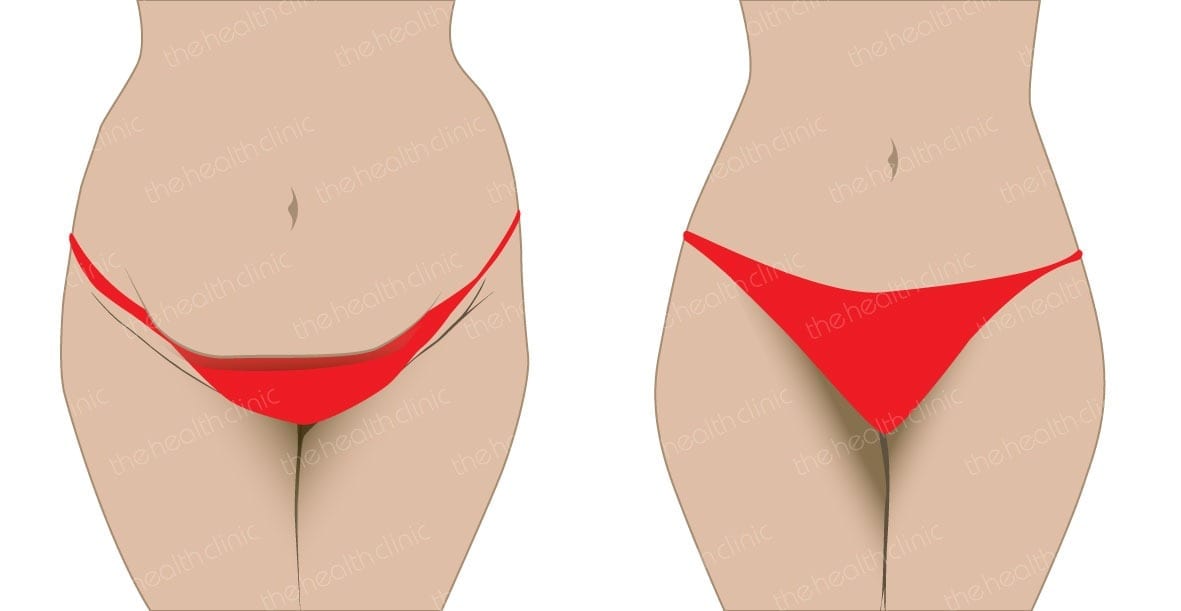Abdominoplasty (tummy tuck) is a good possibility to trim excess and loose skin from the abdominal region. Tummy tuck covers the removal of major adipose tissue and the removal of floppy anterior abdominal skin. Additionally, abdominal muscles can be stretched. Tummy tuck may significantly improve the appearance of squatty belly.
| Surgeon | Dr. Rein Adamson / dr. Martin Adamson / dr. Siim Simmo |
| Anesthesia | General |
| Surgery duration | 1,5-2,5 hours |
| Nights at hospital | 2 |
| Sick leave | 1-2 weeks |
| Price | Lower (mini) abdominoplasty – from €3690 Full abdominoplasty – from €4590 +€600 for liposuction on sides (love handles) |
| Medical loan | starting from €94 per month. Apply here. |
Ask for more information or book a time |
Common problems and solutions
A slim waist is an important factor in terms of external appearance. A stretched abdomen and waist are an important part for men and women in private and professional life.

The possibility to influence changes in the skin and sub-dermal tissue of the rectus abdominis muscle through training, massage or other similar methods is limited because in many cases we are dealing with the rupturing of important supportive structures and the formation of so-called stretch marks. Obtaining a tight waist may also be important after positive changes in life style, when there is weight loss and regular physical exercise is performed.
In this case, abdominoplasty (tummy tuck) is a good possibility to trim excess and loose skin from the abdominal region. Tummy tuck covers the removal of major adipose tissue and the removal of floppy anterior abdominal skin. Additionally, abdominal muscles can be stretched. Tummy tuck may significantly improve the appearance of squatty belly. Naturally, the results also depend on the condition of the skin, sub-dermal tissues and muscles.
What to expect from tummy tuck?
The best possibilities for achieving aesthetically pleasing results are for a slim person in good physical health, whose adipose tissue or floppy skin in the abdominal region does not respond to training or diet.
Once weight loss is planned it is recommended to refrain from surgery until the desired weight is achieved. For women who plan to give birth, the operation should be postponed because the rectus abdominis muscle bundles, which are stretched during the operation, can separate from each other during the course of pregnancy. If there are some scars from previous surgeries, abdominoplasty surgery may be harder to perform.
Tummy tuck (abdominoplasty) leaves a relatively long scar in the bikini region, which becomes, over time, softer and unnoticeable. Additionally, the umbilicus gets a new position, also its shape is changed and a little ring-shaped scar forms.
Besides classical tummy tuck, it is possible to perform partial tummy tuck (mini-abdominoplasty), which requires a smaller incision, and the position of the umbilicus remains unchanged. This is especially suitable in the case of problems with the lower part of the abdomen. It may be that, in addition to total or partial tummy tuck, liposuction must be performed in the hip region. These aspects and possibilities are considered during the planning of your individual surgery.
How to prepare for tummy tuck surgery?
Prior to the planned surgery you should be in as good a health as possible.
Limit your nicotine and alcohol consumption to a minimum. In addition to overall circulation, smoking also harms microcirculation in the surgery area. For this reason, it is recommended that you avoid smoking for a period of two weeks prior to and after the surgery.
The administration of preparations containing hormones (pills, hormonal substitution preparations) must be temporarily suspended.
The use of aspirin or any medicines containing acetylsalicylic acid, for at least 14 days before surgery, is strictly prohibited.
It is recommended that you plan for a postoperative period of 7 to 10 free days because after surgery your physical activity will be limited.
At hospital
As a rule, the operation is performed during a hospital stay for two days. This allows professional medical staff to take care of you during the postoperative period.
Anaesthesia
Tummy tuck is mostly performed under general anaesthesia, meaning you will be asleep during the surgery. Before surgery, the anaesthesiologist will perform the necessary research to ensure that you receive the appropriate anaesthesia.
How is the operation performed?
Tummy tuck typically lasts from 1.5 to 3 hours, depending on the extent of the surgery. The extent of your surgery depends on your specific anatomy, expectations and also on the surgeon’s recommendations.
Basically, the surgery is performed as follows:
Initially, a long incision is made, which runs above the pubic region until the hipbone. Additionally, the umbilicus is removed with a circular incision.
In the case of partial tummy tuck, the incision is markedly smaller and, if necessary, the umbilical cut may skipped. This may mean that the position of the umbilicus moves downwards.
After that, a large section of the skin is removed until the costae, in order permit access to the abdominal muscles. The rectus abdominis muscle bundles are adducted to each other, stretched and attached to a new location. This helps to achieve a more stretched abdomen with a smaller waist.
Skin that has been set aside is thereafter replaced, with surplus skin being removed. After this the umbilicus is attached in a new location.
Narrow drainage tubes help to evacuate fluids and blood from the wound during the first postoperative period (12 to 24 hours). Finally, incisions are attached and the wound bandage is set.
In the case of partial tummy tuck, only the umbilicus and inter-incision skin is stretched. This section of the skin is stretched down, surplus skin is removed and the wound is then closed.
After surgery – what to pay attention to
For the first few days after the operation you will feel pain in the operation area. Therefore, your normal movements will be limited. During this period analgesic preparations are usually prescribed.
Drainage tubes inserted during the surgery are removed, as a rule, on the first postoperative day. The bandage is removed during the following days.
For the first few days after the operation you should allow yourself as much rest as possible, in order to minimise swelling. Generally, possible oedemas, haematomas and skin numbness will disappear completely during the weeks following the postoperative period.
Postoperatively, a previously measured special pressure bandage or tight trousers are applied on the operating table.
Surgical sutures are mainly absorbable and only some safety stitches need to be removed. Initially, the wound appears flushed and solid, but within a few months the wound will turn lighter and will resemble the rest of the skin. Special wound healing ointments may be used 3 weeks after the completion of surgery. The wound area must be kept away from sun light for the first 6 months (appropriate clothing, patches).
Depending on how you feel, you can start everyday activities after a few days; but during the first postoperative week you should still plan to rest.
Exercise is allowed after the sixth week (a special corselet must be worn). Postoperative nicotine and alcohol consumption should be reduced to a minimum, and visits to saunas and steam baths should be avoided for a few months.
Your new look
With the correct indications and realistic expectations, most patients are very pleased with the results and enjoy their new look. Having a new look usually means the beginning of a new phase in life, with increased satisfaction and improved self-esteem.
Can tummy tuck be repeated?
In principle, abdominoplasty may be repeated. Regular check-up visits with your surgeon can help prevent and correct possible complications. If there are problems, a personal decision must be taken regarding what kind of corrective methods should be used.
Gallery with before / after pictures
Tummy tuck surgery is performed by Dr. Rein Adamson, Dr. Martin Adamson or Dr. Siim Simmo, who are experienced body contouring surgeons. Ask for more information or book a time.
